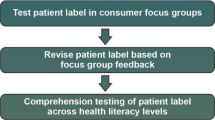Abstract
Purpose
This study assessed patients’ comprehension of the Advair and Serevent medication guides (MGs) and MG reading behaviors with the goal to improve risk communication.
Methods
After reading their assigned MGs, 452 adults with asthma or chronic obstructive pulmonary disease participated in structured interviews to assess comprehension of safety risks in the Advair MG (asthma, n = 150; chronic obstructive pulmonary disease, n = 153) and Serevent MG (asthma, n = 149). Generalized estimating equations for correlated binary data were used to identify factors associated with correct responses.
Results
For 10 of 12 individual risk questions, ≥75% of patients reported correct responses. After adjusting for patient characteristics, health literacy was significantly associated with correct responses (odds ratio = 1.03, 95% confidence interval = 1.02-1.05 per 1-point increase in the Rapid Estimate of Adult Literacy in Medicine). MG reading behaviors were inconsistent, with many patients reading MGs only once (40%) despite multiple prescriptions.
Conclusions
Comprehension of safety risks in the Advair and Serevent MGs was adequate for most patients in the study but decreased with health literacy. Initiatives to improve patient-directed risk communication should consider health literacy and reasons for inconsistent reading behaviors.
Similar content being viewed by others
References
FDA. Medication guides: distribution requirements and inclusion in risk evaluation and mitigation strategies (REMS). http://www.fda.gov/downloads/Drugs/GuidanceComplianceRegulatoryInformation/Guidances/UCM244570.pdf. Accessed October 24, 2013.
Wolf MS, Davis TC, Shrank WH, Neuberger M, Parker RM. A critical review of FDA-approved medication guides. Patient Educ Couns. 2006;62:316–322.
Wolf MS, King J, Wilson EA, et al. Usability of FDA-approved medication guides. J Gen Intern Med. 2012;27:1714–1720.
Shiffman S, Gerlach KK, Sembower MA, Rohay JM. Consumer understanding of prescription drug information: an illustration using an antidepressant medication. Ann Pharmacother. 2011;45:452–458.
Dusetzina SB, Higashi AS, Dorsey ER, et al. Impact of FDA drug risk communications on health care utilization and health behaviors: a systematic review. Med Care. 2012;50:466–478.
FDA. Serevent Diskus medication guide. http://www.fda.gov/downloads/Drugs/DrugSafety/ucm089125.pdf. Accessed October 24, 2013.
FDA. Advair Diskus medication guide. http://www.fda.gov/downloads/Drugs/DrugSafety/ucm111326.pdf. Accessed October 24, 2013.
FDA. Drug safety communication: new safety requirements for long-acting inhaled asthma medications called long-acting beta-agonists (LABAs). http://www.fda.gov/Drugs/DrugSafety/PostmarketDrugSafetyInformationforPatientsandProviders/ucm200776.htm. Accessed October 24, 2013.
ISPE. Guidelines for good pharmacoepidemilogical practices (GPP). Pharmacoepidemiol Drug Saf. 2008;17:200–208.
Davis TC, Long SW, Jackson RH, et al. Rapid estimate of adult literacy in medicine: a shortened screening instrument. Fam Med. 1993;25:391–395.
FDA. Guidance for industry label comprehension studies for nonprescription drug products. http://www.fda.gov/downloads/Drugs/GuidanceComplianceRegulatoryInformation/Guidances/UCM143834.pdf. Accessed October 24, 2013.
Zeger SL, Liang KY, Self SG. The analysis of binary longitudinal data with time independent covariates. Biometrika. 1985;72:31–38.
Doak CC, Doak LG, Root JH. Teaching Patients With Low Literacy Skills. 2nd ed. Philadelphia, PA: Lippincott; 1996.
Wolf MS, Davis TC, Bass PF, et al. Improving prescription drug warnings to promote patient comprehension [Erratum in: Arch Intern Med. 2010;170:608]. Arch Intern Med. 2010;170:50–56.
Allen LaPointe NM, Pappas P, Deverka P, Anstrom KJ. Patient receipt and understanding of written information provided with isotretinoin and estrogen prescriptions. J Gen Intern Med. 2007;22:98–101.
You WB, Grobman W, Davis T, Curtis LM, Bailey SC, Wolf M. Improving pregnancy drug warnings to promote patient comprehension. Am J Obstet Gynecol. 2011;204:318.e1–318.e5.
Disantostefano RL, Yeakey A, Raphiou I, Stempel D. An evaluation of asthma medication utilization for risk evaluation and mitigation strategies (REMS) in the United States: 2005–2011. J Asthma. 2013;50:776–782.
Davis TC, Federman AD, Bass PF 3rd, et al. Improving patient understanding of prescription drug label instructions. J Gen Intern Med. 2009;24:57–62.
Rosas-Salazar C, Apter AJ, Canino G, Celedón JC. Health literacy and asthma. J Allergy Clin Immunol. 2012;129:935–942.
Apter AJ, Wan F, Reisine S, et al. The association of health literacy with adherence and outcomes in moderate-severe asthma. J Allergy Clin Immunol. 2013;132:321–327.
Federman AD, Wolf MS, Sofianou A, et al. Asthma outcomes are poor among older adults with low health literacy [published online October 8, 2013]. J Asthma.
Roberts NJ, Ghiassi R, Partridge MR. Health literacy in COPD. Int J Chron Obstruct Pulmon Dis. 2008;3:499–507.
Miller MJ, Schmitt MR, Allison JJ, Cobaugh DJ, Ray MN, Saag KG. The role of health literacy and written medicine information in nonsteroidal antiinflammatory drug risk awareness. Ann Pharmacother. 2010;44:274–284.
Enger C, Younus M, Petronis KR, Mo J, Gately R, Seeger JD. The effectiveness of varenicline medication guide for conveying safety information to patients: a REMS assessment survey. Pharmacoepidemiol Drug Saf. 2013;22:705–715.
Dal Pan GJ. Commentary on “The effectiveness of varenicline medication guide for conveying safety information to patients: a REMS assessment survey” by Enger et al. Pharmacoepidemiol Drug Saf. 2013;22:716–718.
Papay JI, Fritz D, Catu T, Ellis M, Debussey S. Assessment of a simplified format of written patient prescription drug information. Drug Inf J. 2010;44:375–391.
Aker J, Beck M, Papay JI, et al. Consumers better understand and prefer simplified written drug information: an evaluation of 2 novel formats versus the current CMI. Ther Innov Regul Sci. 2013;47:125–132.
Katz MG, Kripalani S, Weiss BD. Use of pictorial aids in medication instructions: a review of the literature. Am J Health Syst Pharm. 2006;63:2391–2397.
Schillinger D, Piette J, Grumbach K, et al. Closing the loop: physician communication with diabetic patients who have low health literacy. Arch Intern Med. 2003;163:83–90.
US Department of Education. The health literacy of America’s adults: results from the 2003 national assessment of adult literacy. http://nces.ed.gov/pubs2006/2006483.pdf. Accessed October 24, 2013.
Brookings Institution, Engelberg Center for Health Care Reform. Patient medication information. http://www.brookings.edu/about/centers/health/projects/pmi. Accessed October 24, 2013.
Barlas S. Pharmacy provisions of health care legislation are still viable: industry’s agenda is clear, but its future path is not. P T. 2010;35:142–157.
US Food and Drug Administration. Risk evaluation and mitigation strategy (REMS) assessments: social science methodologies to assess goals related to knowledge. http://www.fda.gov/Drugs/NewsEvents/ucm292337.htm. Accessed October 24, 2013.
Author information
Authors and Affiliations
Corresponding author
Rights and permissions
About this article
Cite this article
DiSantostefano, R.L., Beck, M., Yeakey, A.M. et al. Patient Comprehension of Medication Guides for Asthma and Chronic Obstructive Pulmonary Disease Medications. Ther Innov Regul Sci 48, 574–582 (2014). https://doi.org/10.1177/2168479014524407
Received:
Accepted:
Published:
Issue Date:
DOI: https://doi.org/10.1177/2168479014524407



